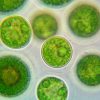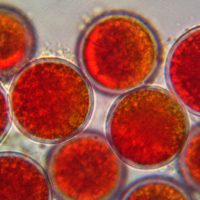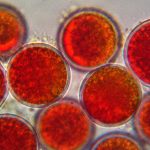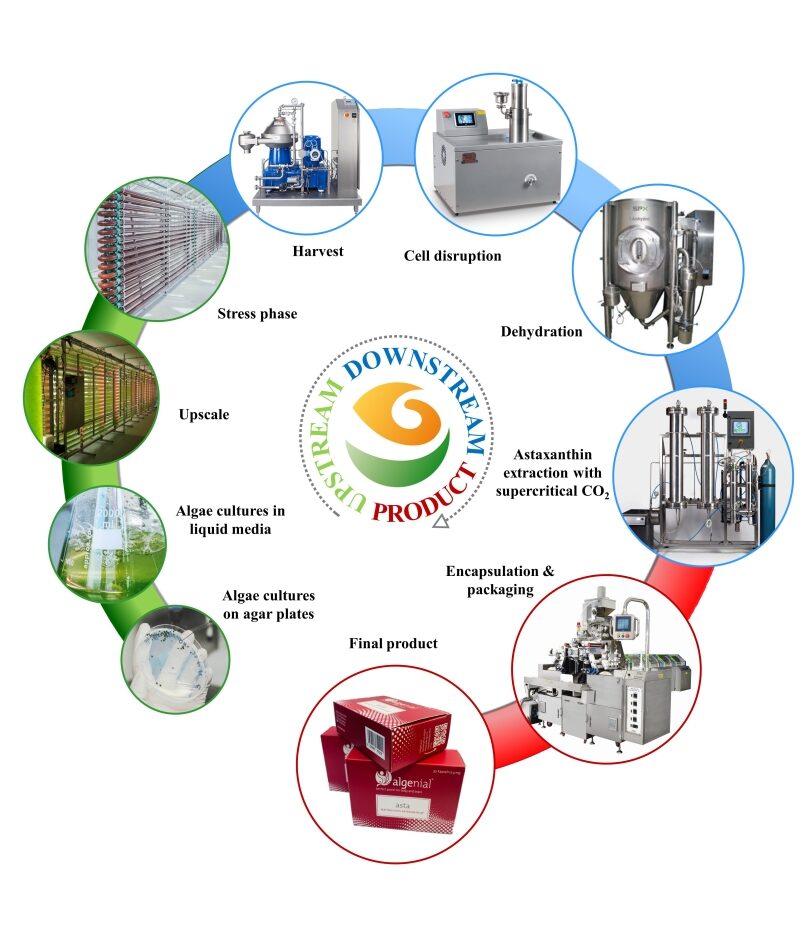The power antioxidant from microalgae

What is Astaxanthin?
There are numerous dyes in nature. We often know them under names such as chlorophyll, beta-carotene or lycopene. They color fruits and vegetables yellow, red, orange or green and are responsible for changing the color of the different seasons. Astaxanthin is also such a reddish dye. A so-called carotenoid (more precisely: xanthophyll). Astaxanthin is also an antioxidant. The most powerful, natural antioxidant in the world.
The task of antioxidants is to neutralize free radicals. Free radicals are chemically unstable compounds that have a high affinity for reactions. Often these are so-called “reactive oxygen groups” (ROS), such as singular oxygen, which arises, among other things, from sunburn. These molecules attack and damage the DNA of cells, the fat layer or other chemical compounds in the body. Such damage leads to skin aging processes, can promote the formation of cancer cells and trigger other diseases.
There are also numerous organisms that accumulate astaxanthin. These include plants (e.g. Adonis aestivalis), yeasts (e.g. Phaffia rhodozyma), fish (e.g. sockeye salmon) or birds (e.g. flamingos). Not all of these organisms are able to produce astaxanthin. The salmon and flamingo take it in through food and accumulate it in their cells or plumage.

What is so special about Astaxanthin?
Compared to other antioxidants, astaxanthin works more effectively. So its antioxidative effectiveness is much stronger than, for example, vitamin E, coenzyme Q10 or vitamin C. This is due to the special molecular structure.

The long-chain molecule has polar end groups with which it can be taken up by cells. The oxygen groups give it its antioxidant effect. Due to its lipophilic properties, it is often esterified and is therefore protected from early oxidation. This is why astaxanthin should always be taken in conjunction with fats, as this increases bioavailability. However, astaxanthin can also bind to proteins, as can be seen from the shell of crustaceans.
Astaxanthin protects the skin from UV damage, supports eyesight and aids in muscle regeneration after intensive strength training. Astaxanthin scores even more than other antioxidants. Some antioxidant substances have a pro-oxidative effect. This means that after free radicals are neutralized, they themselves exist as a reactive molecule and cause damage. This pro-oxidative effect has not yet been demonstrated in astaxanthin. It is also a lipophilic molecule. This means that it is fat-soluble and can be stored well in our skin cells. Because of its unique structure, it can act on both sides of the cell membrane, i.e. outside and inside the cell. In comparison, vitamin C can only act on the outside of the cell membrane (extracellular area), since it is not fat-soluble.
How is Astaxanthin made?
Astaxanthin production takes place in two phases. In the green phase, the algae grow under optimal conditions and form a lot of biomass. In the red phase, the so-called stress phase, the growth conditions are changed so that the algae accumulate astaxanthin in their cells as a stress reaction.
The microalgae biomass for the production of astaxanthin can be produced in various systems. We use closed glass systems for production at our location. These tubes have already proven themselves in other productions and offer various advantages. Compared to open systems (e.g. open ponds), they are less susceptible to contamination. In addition, individual parameters such as pH value, CO2 and O2 content can be better adjusted. Thanks to their optimized, transparent design, higher growth rates and increased astaxanthin levels can be achieved.
After the production, the algae biomass is harvested and processed. The cells are gently separated from the suspension, dehydrated by a spray drying process and the astaxanthin extracted without solvents. This process leaves no residue. The resulting high-purity oleoresin, a fatty astaxanthine extract, serves as a raw material for the production of the final nutritional supplement.



Astaxanthin: synthetic or natural?
There is also synthetic astaxanthin. This is artificially produced in the laboratory from petrochemicals. This form of astaxanthin is less bioavailable than the natural form and is not approved for human consumption, but as an additive for animal feed. Synthetic astaxanthin is often used in aquaculture, for example to give it a color typical of salmon. Rainbow trout, which have a rather white flesh, get a corresponding color in this way and are sold as salmon trout.
Natural astaxanthin is produced using the microalgae Haematococcus pluvialis, a freshwater algae with a very specific growth cycle. The alga begins to grow as a moving, green flagella (A). If the growth conditions deteriorate, the alga changes its morphology and it strengthens its cell wall (B). In this state, the cell loses its flagellation and is no longer free to move. If the stressors continue to increase, the alga begins to accumulate reddish astaxanthin to protect itself (C). Depending on the intensity of the stress factors, the astaxanthin content in the cell continues to increase (D). This state is reversible as soon as favorable conditions arise.
Despite the differences mentioned, the share of natural astaxanthin from microalgae is less than 1% of the world market compared to the synthetic product. This is mainly due to the price difference, since the production effort for natural astaxanthin from microalgae is much higher. Nevertheless, global demand for natural astaxanthin has grown rapidly in recent years.
What is Astaxanthin?

There are numerous dyes in nature. We often know them under names such as chlorophyll, beta-carotene or lycopene. They color fruits and vegetables yellow, red, orange or green and are responsible for changing the color of the different seasons. Astaxanthin is also such a reddish dye. A so-called carotenoid (more precisely: xanthophyll). Astaxanthin is also an antioxidant. The most powerful, natural antioxidant in the world.
The task of antioxidants is to neutralize free radicals. Free radicals are chemically unstable compounds that have a high affinity for reactions. Often these are so-called “reactive oxygen groups” (ROS), such as singular oxygen, which arises, among other things, from sunburn. These molecules attack and damage the DNA of cells, the fat layer or other chemical compounds in the body. Such damage leads to skin aging processes, can promote the formation of cancer cells and trigger other diseases.
There are also numerous organisms that accumulate astaxanthin. These include plants (e.g. Adonis aestivalis), yeasts (e.g. Phaffia rhodozyma), fish (e.g. sockeye salmon) or birds (e.g. flamingos). Not all of these organisms are able to produce astaxanthin. The salmon and flamingo take it in through food and accumulate it in their cells or plumage.

What is so special about Astaxanthin?
Compared to other antioxidants, astaxanthin works more effectively. So its antioxidative effectiveness is much stronger than, for example, vitamin E, coenzyme Q10 or vitamin C. This is due to the special molecular structure.

The long-chain molecule has polar end groups with which it can be taken up by cells. The oxygen groups give it its antioxidant effect. Due to its lipophilic properties, it is often esterified and is therefore protected from early oxidation. This is why astaxanthin should always be taken in conjunction with fats, as this increases bioavailability. However, astaxanthin can also bind to proteins, as can be seen from the shell of crustaceans.
Astaxanthin protects the skin from UV damage, supports eyesight and aids in muscle regeneration after intensive strength training. Astaxanthin scores even more than other antioxidants. Some antioxidant substances have a pro-oxidative effect. This means that after free radicals are neutralized, they themselves exist as a reactive molecule and cause damage. This pro-oxidative effect has not yet been demonstrated in astaxanthin. It is also a lipophilic molecule. This means that it is fat-soluble and can be stored well in our skin cells. Because of its unique structure, it can act on both sides of the cell membrane, i.e. outside and inside the cell. In comparison, vitamin C can only act on the outside of the cell membrane (extracellular area), since it is not fat-soluble.
How is Astaxanthin made?
Astaxanthin production takes place in two phases. In the green phase, the algae grow under optimal conditions and form a lot of biomass. In the red phase, the so-called stress phase, the growth conditions are changed so that the algae accumulate astaxanthin in their cells as a stress reaction.









